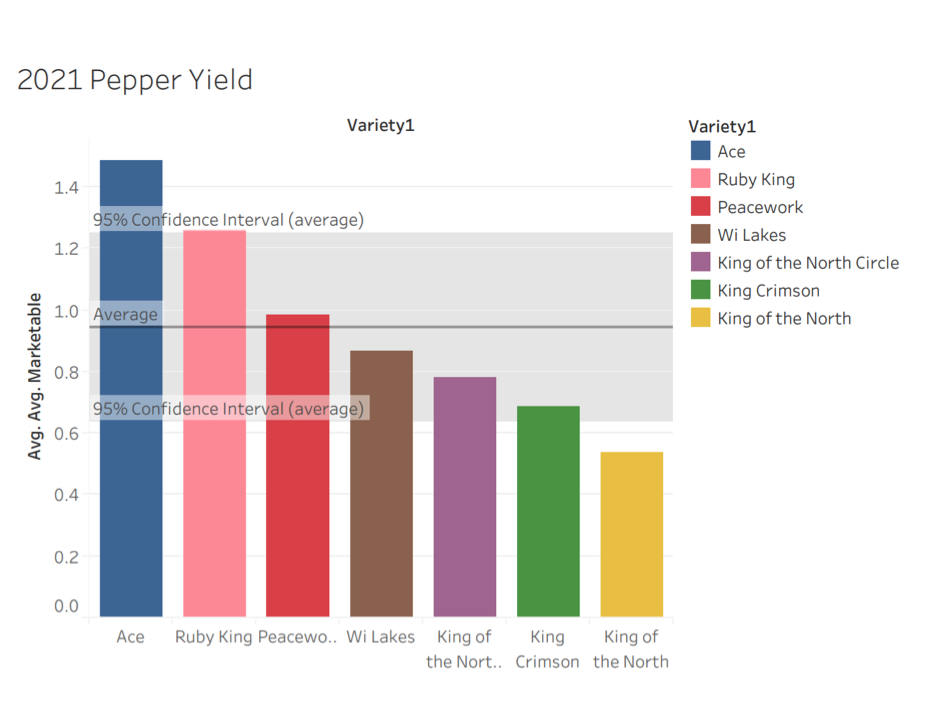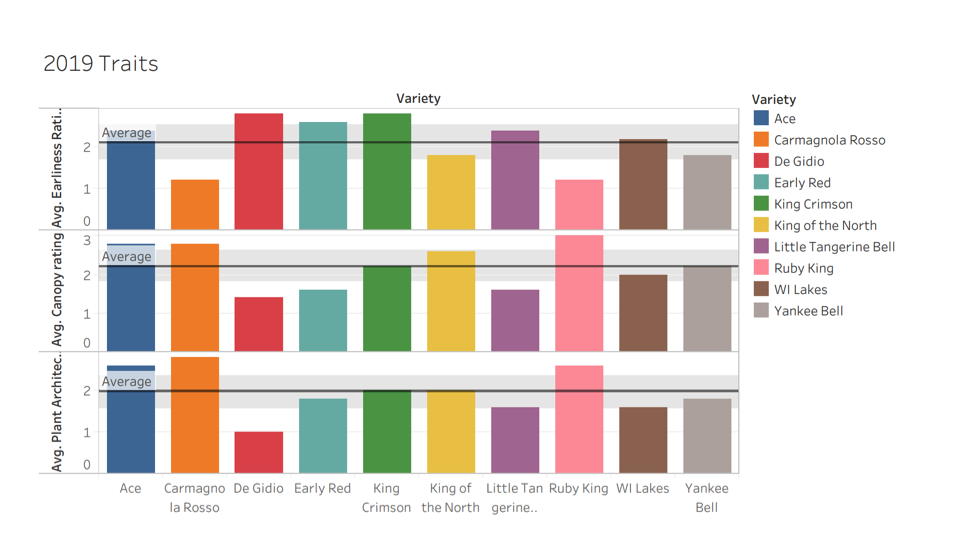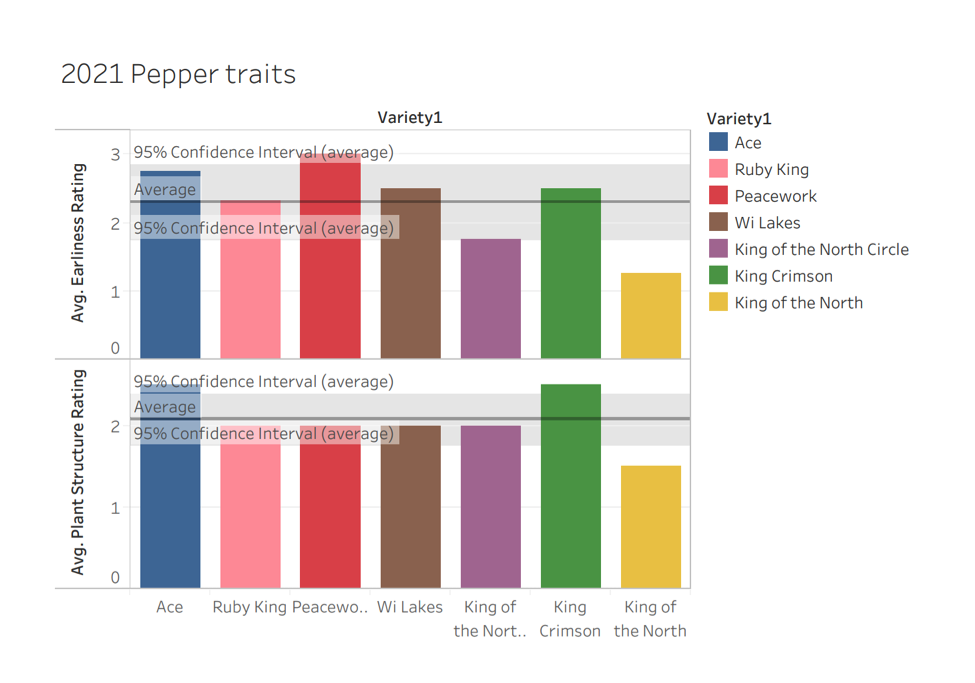Northern Sweet Pepper Trial Report 2019-2021 - Organic Seed Alliance

Publication date: March 29, 2022
Author: Kitt Healy and Michael Lordon, Organic Seed Alliance
Funder: USDA Specialty Crop Block Grant Program through the Minnesota Department of Agriculture
Table of Contents
Introduction
Bell-shaped sweet peppers can be a valuable crop for vegetable producers in the Upper Midwest. Ripening peppers in the short summer growing season, and avoiding diseases that thrive in humid environments can be a challenge. Most organic vegetable producers rely on hybrid varieties of bell peppers, which tend to be more productive and more disease resistant than open-pollinated varieties, likely due to the effort that seed companies and plant breeders put into selecting the parent lines of hybrid varieties for desirable traits.
This trial was conducted to evaluate the performance of several open-pollinated (OP) varieties of sweet bell peppers bred or selected in the northern United States. The trial focused on OP varieties with the intention of identifying varieties that could serve as parents for farmer-led breeding and selection initiatives in the future. This trial was funded by a Specialty Crop Block Grant through the Minnesota Department of Agriculture and was accompanied by educational and networking opportunities for farmers to grow their capacity to save and select seed on their farms.
Collaborators, Materials, and Methods
The trial was conducted on two farms in southeastern Minnesota: Sogn Valley Farm and Riverbend Farm. The trials were designed in a randomized complete block design, with two replications at one site, and three replications at the other site. The growers managing the trials were asked to use their normal production methods on the trial plots to ensure that the results would be relevant to other growers who cannot create highly controlled research environments on their farms. This method of trialing with the methods of the Seed to Kitchen Collaborative at the University of Wisconsin-Madison, which has spearheaded decentralized, collaborative variety trialing methods in the Upper Midwest.
In 2019, ten varieties of sweet pepper were chosen for the trial based on the following criteria:
- History of selection or performance in northern climates
- Reported earliness
- Reported good flavor
Nine out of the ten trial varieties were open-pollinated. One hybrid, ‘Ace,’ was included as a check variety, since it is a reliable variety commonly chosen by growers in this region. One additional variety, ‘Doe Hill,’ was planted as a border at the edges of the trial plots. These are small yellow bell peppers known for their uniquely pleasing flavor and high productivity. They were not evaluated as part of the formal trial, but were included in the breeding work that arose from the trial.
In 2020, the trial hosts decided that they did not want to continue producing some of the low yield, small size, and slow ripening varieties from the trial. To honor this request, ‘DiGidio,’ ‘Carmagnola Rosso,’ ‘Early Red,’ and ‘Little Tangerine Bell’ were dropped from the trial. Unfortunately, the COVID-19 pandemic and extreme weather events of 2020 made data collection unrealistic for the participating farmers. So the trial was put on hold until 2021. That year, organic seed sales were extremely high and many seed companies sold out of popular seeds or put restrictions on seed sales that favored production farmers. This made seed sourcing difficult, so the 2021 trial included a subset of eight pepper varieties, including three (‘Quarato d’Asti,’ ‘King of the North Circle’, and ‘Peacework’) that had not been included in the 2019 trail. ‘Yankee Bell’ and ‘Carmagnola Rosso’ were dropped because seeds were unavailable.
In both years of the trial (2019 and 2021), the farm crew at each site led data collection. Marketable yield was weighed at harvest time and other traits of interest were rated on a 3-1 scale. In 2019, the traits of interest were: earliness (date of first harvest), plant architecture (uprightness, branch structure, and branch strength), and canopy cover. In 2021, the farmers combined the second two traits under the umbrella of “plant structure” and rated that on a 3-1 scale. Plants that experienced high levels of lodging, breaking or sunscald were rated low (1) for plant structure.
For all traits except yield, ratings were used instead of measurements in order to decrease the burden of data collection on the growers. Ratings proved to be very useful in providing a sketch of the varieties’ characteristics relative to each other, but not necessarily useful in providing a comprehensive profile of each variety. Research groups such as the Seed to Kitchen Collaborative in Madison, WI and SeedLinked have found that ratings can be especially effective for trials with large numbers of participants. In that sense, this trial may not have been ideal for ratings, but practicality demanded that the trials be designed with farmers’ time and work flow in mind.
| Variety | Source | 2019 | 2021 | Description |
|---|---|---|---|---|
| Ace | Johnny’s Selected Seeds | ✓ | ✓ | Red, medium 3-4 lobed bell fruits |
| Carmagnola Rosso | Seeds of Italy | ✓ | Red, large bell shape, thin skin, slight taper on the end | |
| DeGidio | MN Farmer Variety | ✓ | Red, small bull-horn shape | |
| Early Red | Meadowlark Hearth | ✓ | Red, thin walled, medium bell shape | |
| King Crimson | High Mowing Organic Seeds | ✓ | ✓ | Red, medium blocky shape, thick walled |
| King of the North | High Mowing Organic Seeds | ✓ | ✓ | Red, glossy, thick walled, medium blocky shape |
| Ruby King | Seed Savers Exchange | ✓ | ✓ | Red, thin-walled medium bell shape |
| WI Lakes | Nature and Nurture Seeds | ✓ | ✓ | Red, medium bell shape, medium walled |
| Yankee Bell | Johnny’s Selected Seeds | ✓ | Red, medium blocky-shape | |
| King of the North Circle | North Circle Seeds | ✓ | Red, medium bell-shape, tapered end, thick walled | |
| Peacework | Fedco Seeds | ✓ | Red, medium blocky shape, thick walled | |
| Quadrato D’Asti | Seeds of Italy | ✓ | Red, large bell shape, thick walled |
| Trait | High (3) | Low (1) |
|---|---|---|
| Earliness | Early | Late |
| Canopy (2019) | Leafy, full | Sparse |
| Plant architecture (2019) | Strong, upright | Weak, sprawling |
| Plant structure (2021) | Upright, strong branches, low lodging, low sunscald | Weak, breaks easily, high lodging, high sunscald |
Challenges
The COVID-19 pandemic posed the greatest challenge to the trial. Everyone’s priorities shifted in 2020 and it was difficult for growers and researchers to devote their attention to tasks that once seemed easy. The lingering effect of COVID-era priority shifting, coupled with unforeseen weather events, destroyed the trials in 2020 and lowered yields in 2021. This was coupled with a shortage of popular seed varieties due to increased demand in 2020 and 2021. Finally, differing levels of technological aptitude among the trial hosts meant that some records were kept electronically (via SeedLinked) and some were kept by hand.
Results
Perhaps the most obvious result of these trials was that the hybrid check variety ‘Ace’ out-yielded the other trial varieties in both years and both locations. This is not surprising given the effects of hybrid vigor and the resources generally devoted to breeding hybrids. ‘Ruby King,’ ‘Peacework,’ and ‘Wisconsin Lakes’ all had decent yield relative to the OP group, and may be good candidates for future sweet pepper breeding efforts. ‘King Crimson’ was also a high yielder in the first year but was middling in the second year. This could be due to random error, or since the growers reported above average levels of branch breaking with this variety, which may have decreased yield in the extreme weather events in 2021.
Three varieties were dropped after the first year of the trial because of low performance. The growers agreed that they did not want to put energy into growing these varieties even if a second season of data would have been useful. ‘DiGidio’ was dropped because it ended up having a different shape (bullhorn) than was described by the seed saver, and wasn’t very marketable. ‘Early Red’ and ‘Little Tangerine Bell,’ despite being flavorful and productive, were ultimately too small to meet the growers’ requirements for market.
‘King of the North’ is a favorite variety among northern growers since it was selected in northern latitudes and supposedly produces large fruit earlier in the season. In this study, however, ‘King of the North’ was not an early producer nor a high yielder, and it was unremarkable in the other traits measured. This suggests that Northern growers looking for an OP variety may want to consider other options besides ‘King of the North,’ despite the clever marketing. ‘King of the Circle,’ which is a more recent selection out of ‘King of the North,’ faired similarly over all.




Next Steps
This variety trial yielded one successful cross between ‘Doe Hill’ (a border variety) and ‘Wisconsin Lakes.’ The progeny of this cross are currently (as of writing in 2022) in use by the Upper Midwest Collaborative Plant Breeding Network to develop new breeding populations of northern adapted sweet pepper. In the summer of 2021, 23 farmers across the Upper Midwest grew out the F3 generation of this pepper population and 10 growers returned selections to the network organizers. Those single plant selections were rated highly for flavor, marketability, disease resistance, and overall productivity. Given the information in this report, there is opportunity for further collaborative breeding work involving the high performing OP varieties. It would be an interesting challenge to try and create an OP variety that out-competes ‘Ace’ in the Upper Midwest, developed through the shared selection effort of a network of grower-breeders.
Citation: Healy, K. and Lordon, M. 2022. Northern Sweet Pepper Trial Report 2019-2021. Organic Seed Alliance, Port Townsend, WA. 9 pp.
Copyright 2022 Organic Seed Alliance
Educational Materials: This report is protected under a Creative Commons license: Attribution, Non-Commercial, and Share Alike. We believe in protecting intellectual property (IP) in a manner that promotes creativity and innovation in the interest of the public good. We encourage you to learn more about the Creative Commons, the open source movement, and other alternative IP models.
Organic Seed Alliance is the license holder of this proceedings. You are free to share (to copy, distribute, and transmit the work) and remix (to adapt the work) under these conditions:
- Attribution: You must attribute the work in the manner specified by the author or licensor (but not in any way that suggests they endorse you or your use of the work).
- Noncommercial: You may not use this work for commercial purposes.
- Share Alike: If you alter, transform, or build upon this work, you may distribute the resulting work only under the same or similar license to this one.
For any reuse or distribution, you must make clear to others the license terms of this work. The best way to do this is with a link to the Creative Commons web page: creativecommons.org. Any of the above conditions can be waived if you get permission from the copyright holder. Nothing in this license impairs or restricts the author’s moral rights. Your fair use and other rights are in no way affected by the above.
For PDF versions of this and other seed publications, please visit OSA’s Resource Library

